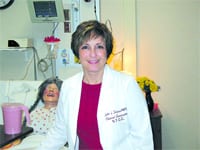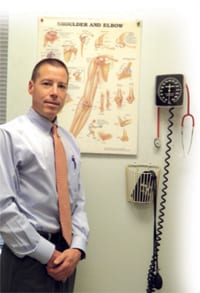Breathing Easier Many Are Calling Respiratory Therapy a Second Career
In this issue, The Healthcare News launches a monthly series examining career opportunities in health care. Each month, we’ll delve into one medical specialty, discuss what the job market is like in that field, and learn about some of the college programs available in Western Mass. to support that field. To begin our series, we take a look at respiratory therapy, and a program at Springfield Technical Community College that’s unique in the region.
Lung disease affects almost 40 million Americans — a number that’s on the rise as the population ages. That’s one reason why the need is growing for qualified respiratory therapists — a need, unfortunately, that is not being met.
“The sometimes overshadowed fact is that the vacancy rate for this position is growing and will become a crisis situation if not addressed,” said Richard Oliver, dean of the University of Missouri-Columbia School of Health Professions.
According to a 2005 report by the American Association for Respiratory Care (AARC), the shortage of respiratory therapists continues to worsen. The vacancy rate in hospitals, about 6{06cf2b9696b159f874511d23dbc893eb1ac83014175ed30550cfff22781411e5} in 2000, has nearly doubled since then.
“Respiratory therapists are often the first line of intervention for patients,” Oliver said. “They are critical care experts and practitioners with high levels of expertise in the use of life-supporting systems like the mechanical ventilator.”
The U.S. Department of Labor reports that allied health professions, the umbrella under which respiratory therapy is placed, represent 60{06cf2b9696b159f874511d23dbc893eb1ac83014175ed30550cfff22781411e5} of the American health care workforce, and among these specialties, respiratory therapy represents the area of greatest need, with a predicted 32{06cf2b9696b159f874511d23dbc893eb1ac83014175ed30550cfff22781411e5} growth rate in job opportunities by 2012.
In Western Mass., Springfield Technical Community College is helping to fill that need with the only Respiratory Therapy degree program in the region. But the students it’s attracting are not the typical fresh faces out of high school.
“It’s set up to be an associate’s degree program, but most people spend three or four years working toward it; nobody walks right into it,” said Lee Robinson, chair of the Respiratory Care department, noting that STCC tends to graduate older, more mature students from this program than most others. “A lot of these programs won’t even take high school kids; most times you spend your first year doing prerequisites.”
In fact, said Esther Seligman, assistant professor and clinical coordinator, most enrollees in STCC’s program are older than the typical college student, and about half see respiratory therapy as their second job. “They’re in one area of the workforce, and they want to try something different.”
That’s true of many fields of medicine, of course; oft-repeated news that health care is the top employer in Massachusetts, growing all the time, yet still beset by shortages, has caused many people in less-secure careers to switch careers. But Robinson said respiratory therapy is also gaining plenty of recruits from other health fields.
“People want to move up,” he said. “They’ve been a nurse’s aide, they’ve been an EMT, they’re already in health care, but they can make more money and have more responsibility doing this.”
Air of Excitement
But what is it about respiratory therapy that attracts applicants to STCC’s program — besides ample opportunity, of course? For one thing, Seligman said, the job is fast-paced, varied, and rarely boring.
“We basically take care of patients who have respiratory and cardiac issues,” Seligman said. “We deliver medicines via the airway and treat people who have breathing issues. We do electrocardiograms, set people up on oxygen, and take care of the airway. If people end up in the ICU on breathing machines, we run those.”
It’s in effect a birth-to-death field of care, as therapists treat premature babies and very elderly patients — and everyone in between, from patients facing life-or-death situations after accidents to participants in decidedly less-stressful situations, such as sleep studies.
Seligman said some applicants are attracted to the program — from which STCC graduates about 15 per year — because they have some experience in their family, such as a father who was on a respirator. “But most of the time, people don’t realize how much we do. They’re shocked at what they have to know.”
She noted that the field allows — demands, even — a lot of autonomy in assessing a condition and deciding on a course of action. That requires a certain decisive personality right off the bat. “We are one of the few programs that, upon graduation and credentialing work, immediately sends people to work in critical care units,” she noted. “In other professions, such as nursing, you get time under your belt before working in critical areas. But we have to be there right away; it’s the nature of what we do.”
To prepare students for those situations, STCC puts its growing population of high-tech patient simulators to work, which puts students in realistic situations much earlier than they could at programs that lack sims.
“You can even do a lot of transporting critically ill patients through the halls here, which is important, because you can’t always bring the equipment to them; you have to have it wherever people have to breathe,” Robinson said. “It’s great that we can simulate that here.”
He said respiratory therapy graduates, like nurses, are usually scooped up by recruiters right away, and many wind up working in Western Mass. and the Worcester, Boston, and Hartford areas. “Mass. General and Children’s Hospital are always hiring,” he said of two noted Boston facilities, “and Hartford Hospital has always been after our students.”
Salary levels, however, still have a way to go, although they are improving, Robinson said, as they currently start at around $40,000 to $45,000, depending on the region — a little below nursing, another field with an extensive and growing shortage.
But with placement out of STCC’s program running at 100{06cf2b9696b159f874511d23dbc893eb1ac83014175ed30550cfff22781411e5}, the fact that no one has trouble finding work is in itself a draw.
“With manufacturing shops closing, things like that, people are forced to relocate to a different region, or stay and pursue something different,” Seligman said. “One option is health care. People know the jobs are there.”


